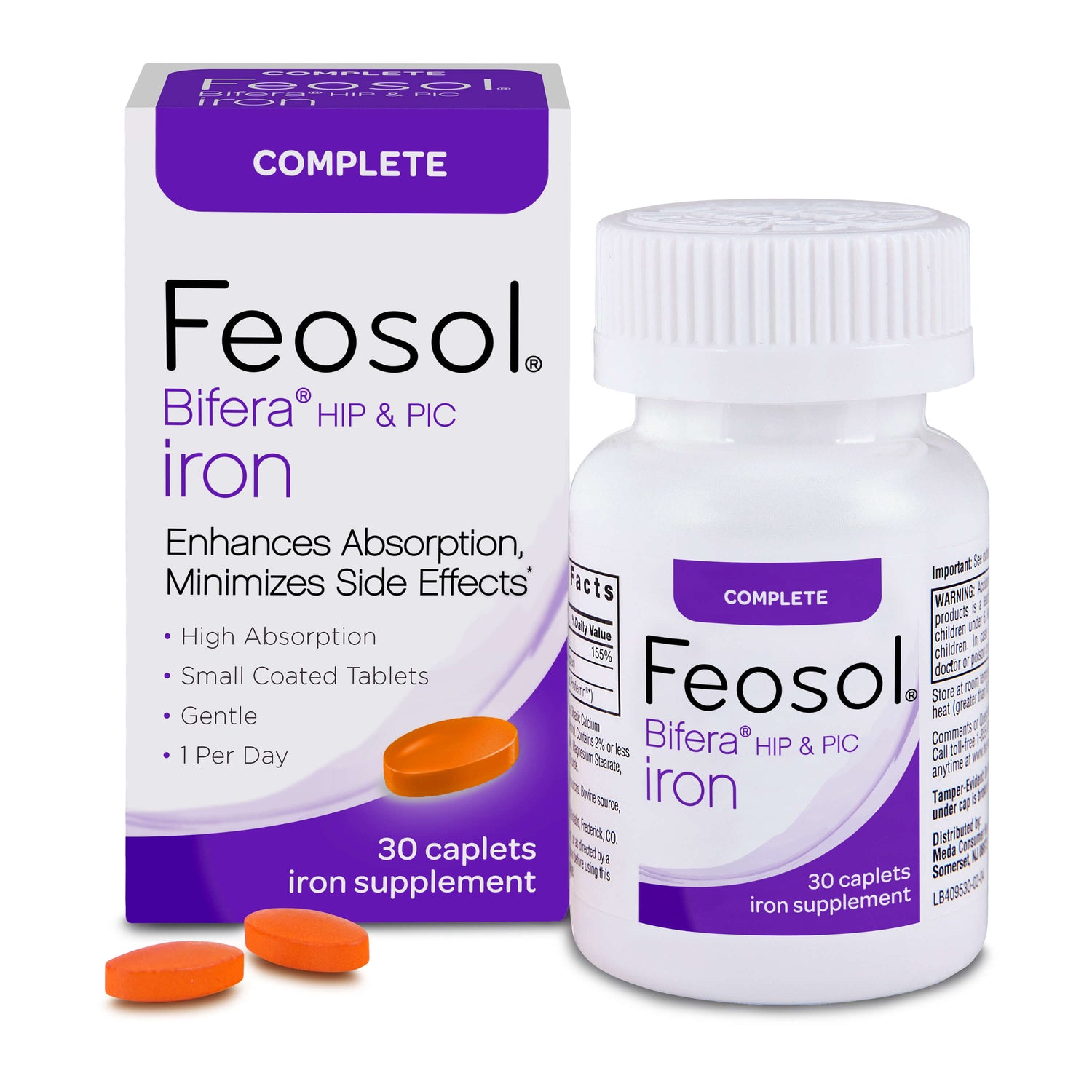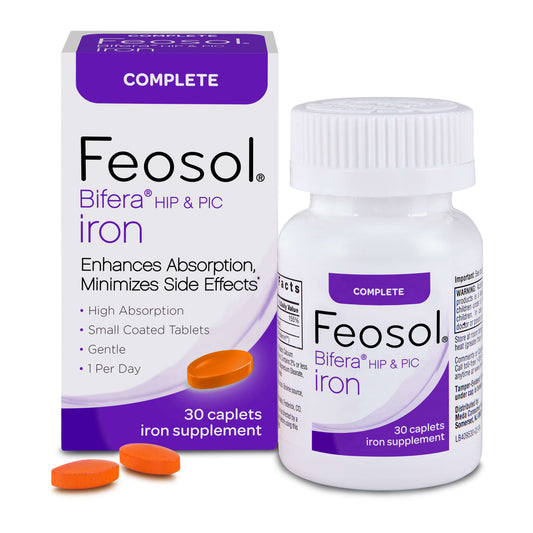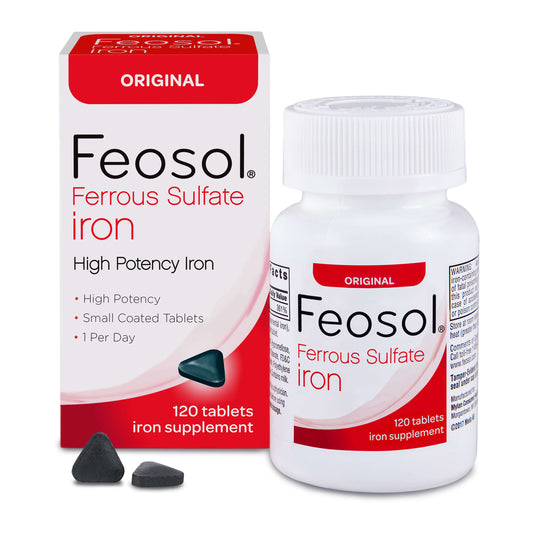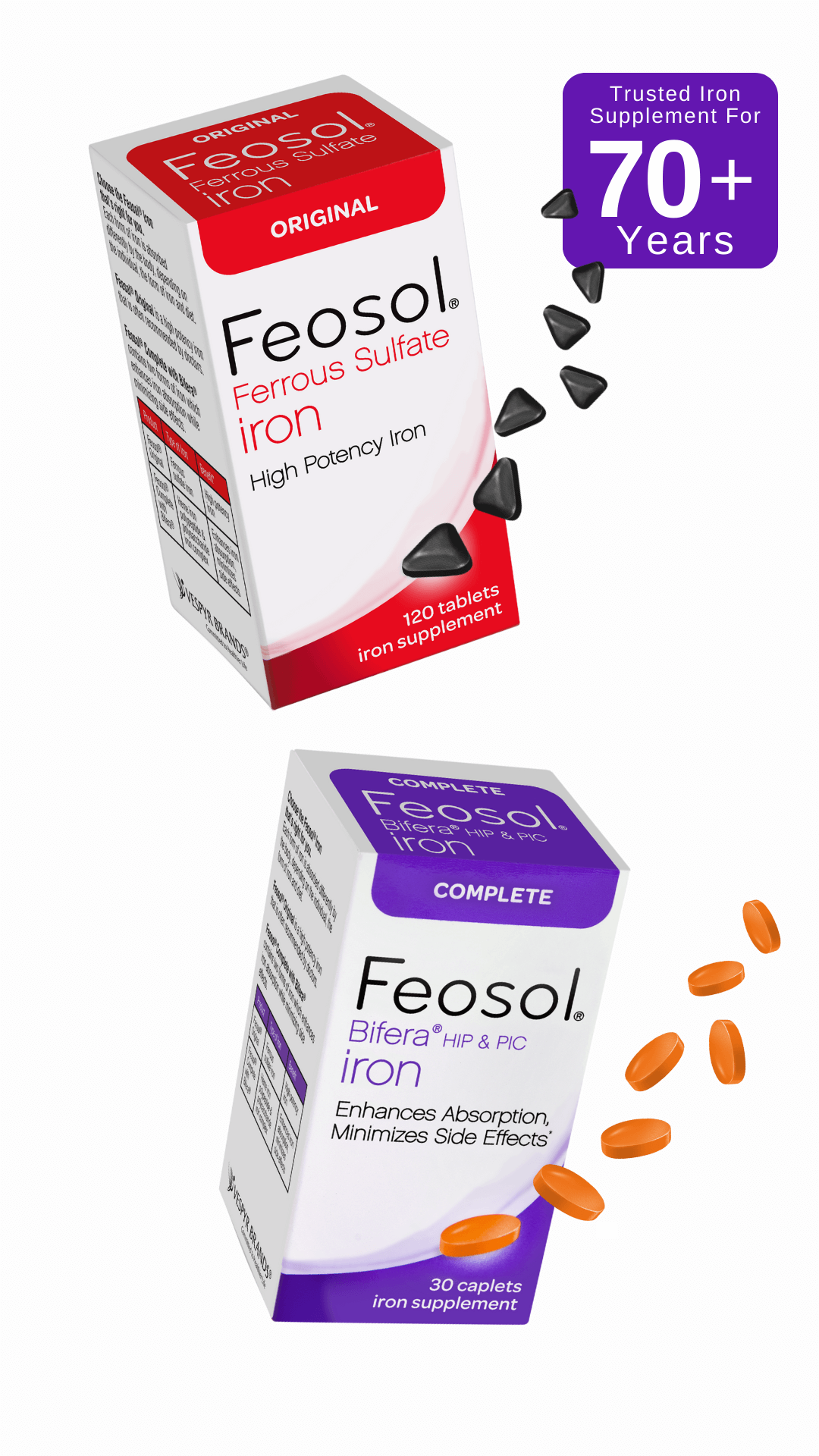
An Iron As Unique As You Are
Feosol offers two distinct types of iron each with unique benefits. Original for the most common form of iron and Complete for better absorption and less stomach side effects*. Find out which Feosol is right for you.
As seen in
-
Feosol Complete
Regular price $19.99Regular priceUnit price per -
Feosol Original
Regular price $10.99Regular priceUnit price per

The Benefit of Iron Supplementation
Iron deficiency is the most common nutritional deficiency in the United States. Iron is an essential mineral that helps muscles store and use oxygen and helps carry oxygen from our lungs to the rest of our bodies. When you are low in iron you may feel tired, sluggish and worn out.
Which Feosol is right for you?
Why do we offer two different formulas? Your body absorbs each form of iron differently, depending on many factors including: your diet, your current iron stores and the type of iron itself.
-
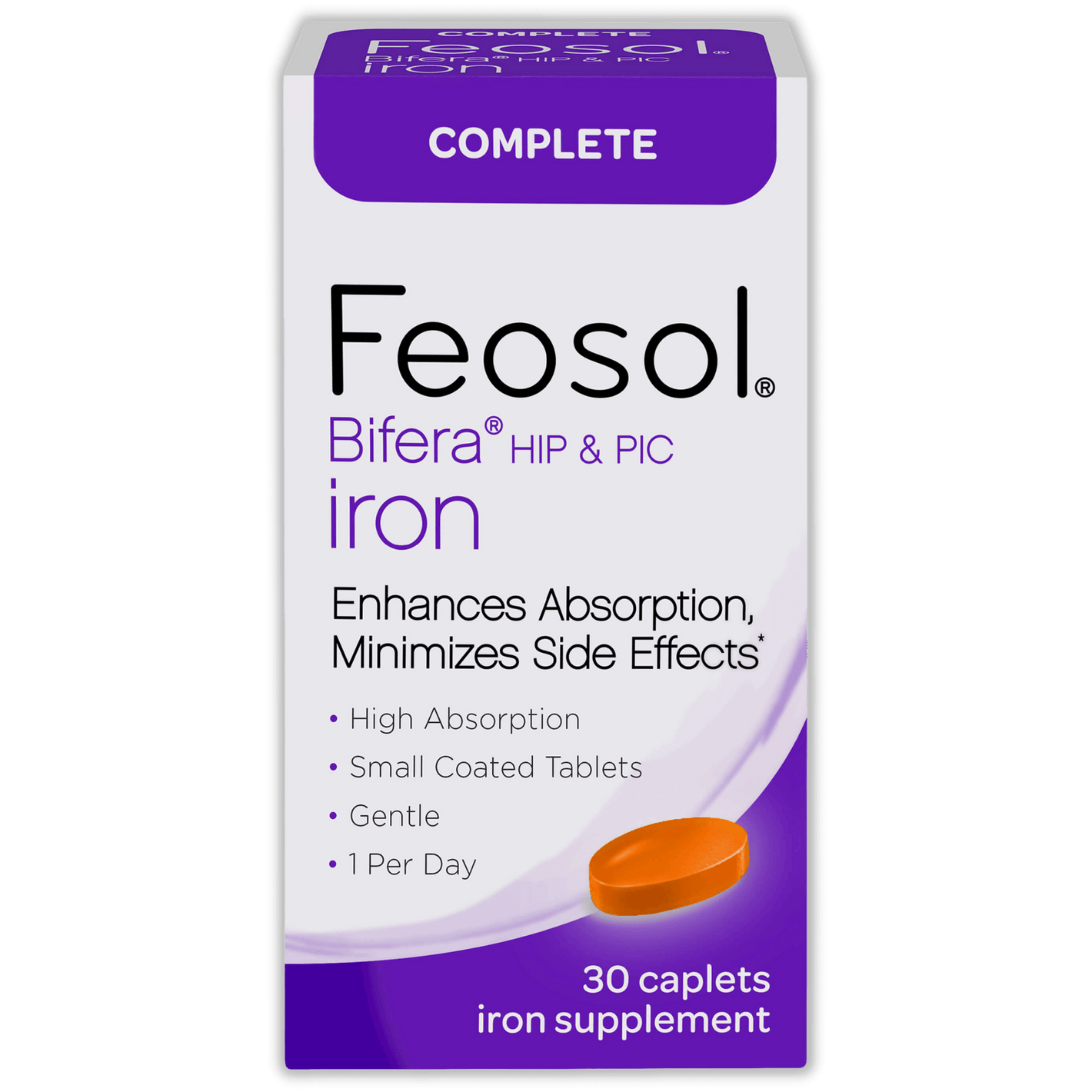
Feosol Complete
Shop Feosol CompleteHeme + Non-Heme Iron
Enhanced Absorption
Extra Gentle on the Stomach
Take Anytime Without Food
-

Feosol Original
Shop Feosol OriginalNon-Heme Iron
High Potency
Great Iron Supplement Value
Take with Food
Real Reviews from Real Customers
Top FAQs
What is iron?
Iron is a building block in the architecture all around us, as well as a building block of all plant and animal life.
Dietary iron is readily available through many types of food. However, nutritional deficiencies, increased iron needs and poor absorption of dietary iron mean that some people aren’t able to get adequate iron from their diets alone. For these reasons, iron deficiency is the #1 most common nutritional deficiency in the United States.
Iron is vital for maintaining energy levels and good health in general because it is an important part of your blood’s hemoglobin. Hemoglobin (in your red blood cells) helps supply your body’s cells with oxygen, so when you are low in iron, your body may not be getting the oxygen it needs. The end result is that you may feel tired, sluggish and worn out.
Iron supplements are recommended by doctors when dietary intake of iron cannot restore a person’s iron levels to normal in a satisfactory timeframe. However, the dose of iron your physician prescribes depends on your current storage level of iron, hemoglobin and the type of iron they want you to take.
Some forms of iron are better absorbed than others and therefore the dose prescribed depends on the type of iron. In addition, your doctor may recommend that you start with a smaller dose of iron and gradually increase the dose to minimize side effects.
Why is iron important?
Just like you need your lungs to breathe in oxygen, you need your blood to deliver that oxygen to all of the cells throughout your body.
Iron is a part of that blood-oxygen delivery system, and without proper levels of iron, you may begin to feel the weakening effects of low iron: tired all of the time, pale, listless and irritable.
Each and every cell in your body needs oxygen to produce energy. Not just for exercise, but for everyday life: brushing your teeth energy, walking up the
stairs energy, going to work energy, baking cookies energy.
When you have normal iron levels, you have enough energy in every one of your body cells. Without enough iron, your cells produce less energy.
How does iron help out? As oxygen moves from your lungs into the blood, iron helps your red blood cells to “grab” the oxygen and to carry it to all parts of your body.
How do I know if I have iron deficiency anemia?
There are several symptoms that you can look for to help determine if you have an iron deficiency (lethargy, irritability, low energy, paleness, dizziness), but there’s no way to know for sure without a blood test and a doctor’s assessment and/or examination.
Iron deficiency is the single-most common nutritional deficiency in the U.S. If you have any of the symptoms above or if you are concerned about a lack of iron in
your diet, talk to your healthcare provider about iron deficiency anemia testing. Keep in mind that some people are asymptomatic, or experience none of the common symptoms, so the only way to be
sure is a blood test.
If your levels are too low, you may have iron deficiency anemia. Your healthcare provider will want to talk about any medications you are currently taking, your diet and eating habits, and he or she will rule out serious health problems
that could have caused low iron in your blood.
Last you will discuss ways to manage your iron deficiency, including an iron-rich diet and supplementation.
Can I be tested for Iron deficiency anemia?
If you are concerned about iron deficiency anemia, talk to your healthcare provider. He or she
may assess the iron in your blood with two common blood tests:
- A test to measure the hemoglobin in your blood
- A hematocrit to determine the percent of red blood cells in your blood
If your hemoglobin and your hematocrit are low, you may have iron deficiency anemia. Your healthcare provider will rule out serious health problems that could have caused low iron in your blood, and discuss ways you can get rid of your iron deficiency.
Can’t I get iron through food?
Iron is readily available through many types of food. However, nutritional deficiencies, increased iron needs and poor absorption of dietary iron mean that many people aren’t able to get adequate iron from their diets alone. For these reasons, iron deficiency is the most common nutritional deficiency in the United States.
There are two types of iron found in food, heme and non- heme. Heme iron is derived from hemoglobin and therefore found in animal foods including meat, fish and poultry.
Non-heme iron is found in plants and also added to fortified and enriched foods including cereal, some nutrition bars and bread. Absorption of heme iron ranges from 15-35% whereas non-heme iron absorption is 2-20%.
In addition, heme iron absorption is efficient and not significantly affected by what is eaten concurrently. However, absorption of non-heme iron is influenced by several dietary factors making what is eaten with a food rich in non-heme iron, important.
Food Combinations
In addition to choosing foods high in iron, you can increase your body’s absorption of non-heme iron if you pair it with the right foods. Both meat protein and vitamin C rich foods increase the body’s absorption of non-heme iron. Try eating iron-fortified cereal with a glass of orange juice or making a salsa or Texas caviar with iron-rich beans and vitamin C-rich tomatoes. You can also top a hamburger with slices of tomato so you better absorb the iron in your iron fortified hamburger bun. Another good suggestion – add vitamin C rich citrus fruit to spinach salad.
Dietary Restrictions Inhibit Iron Absorption
Individuals with dietary restrictions, particularly vegetarians, are vulnerable to iron deficiency, despite the fact that many vegetarians eat a well-rounded diet of iron-rich foods. That’s because the iron found in plant-based foods (non-heme iron) is not as well absorbed as iron found in animal-based foods (heme iron).
Consider Iron Supplements
If you suspect you may not be getting adequate iron from your diet, or you fall into any of the above categories, ask your doctor about an iron test. If he or she determines that you are iron deficient, ask about iron supplements to help get your iron levels back on track.
What is the difference between heme and non-heme iron?
There are two forms of dietary iron: heme and non-heme. The difference between heme and non-heme iron is simple: heme iron is derived from hemoglobin; non-heme irons do not come from an animal source.
Heme Iron
What is it: Food sources that contain hemoglobin also contain heme iron: pork, red meat, fish & poultry.
Foods that contain iron: One serving of chicken livers, clams, or roasted beef tenderloin contains all the iron you need for a day.
Absorption: Heme iron is absorbed better than non-heme iron, and its absorption is not affected by other things you eat. You absorb 15-35% of the heme iron you eat!
Non-Heme Iron
What is it: All non-meat based iron is non-heme iron.
Foods that contain iron: Non-heme iron is found in vegetables, grains, iron-fortified cereal, lentils & beans.
Absorption: Non-heme iron is not absorbed by the body as well as heme iron. Only 2-20% of non-heme iron is absorbed.
